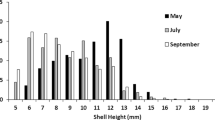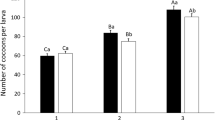Abstract
An entomophilic nematode, Thripinema nicklewoodii (Tylenchida: Allantonematidae) and an endoparasitic wasp, Ceranisus sp. (Hymenoptera: Eulophidae) were recently recovered from western flower thrips (WFT) in California. Observations suggest nematode transmission into WFT occurs while the thrips feed on the plant. Females parasitized by the nematode appear to be reproductively sterile. The parasitic wasp was collected in samples of thrips-infested alfalfa and garden roses. Under laboratory conditions it predominantly oviposited into first instars, resulting in WFT death at the pre-pupal stage. Host-feeding was common. Identification of the wasp to the species level remains undetermined.
Access this chapter
Tax calculation will be finalised at checkout
Purchases are for personal use only
Similar content being viewed by others
References Cited
Lysaght, A. M. 1937. An ecological study of a thrips (Aptinothrips ru/us) and its nematode parasite (Anguillulina aptini). J. Anim. Ecol. 6: 169–192.
Morse, J. G., T. S. Bellows & Y. Iwata. 1986. Technique for evaluating residual toxicity of pesticides to motile insects. J. Econ. Entomol. 79: 281–283.
Murai, T. 1990. Rearing method and biology of thrips parasitoid, Ceranisus menes. SROP/WPRS Bull. 13(5): 142–146.
Nickle, W. R. & G. S. Wood. 1964. Howardula aptini Sharga (1932) parasitic in the blueberry thrips in New Brunswick. Can. J. Zool. 42: 843–846.
Reddy, Y. N., W. R. Nickle & P. N. Rao. 1982. Studies on Howardula aptini (Nematoda-Sphaerulariidae) parasitic in Megaluriothrips sp. in India. Ind. J. Nematol. 12(1): 1–5.
Russell, H. S. 1912. An internal parasite of Thysanoptera. USDA Bur. Ent. Bull. Tech. Ser. 23: 25–52.
Uzel, H. 1895. Monographie der Ordnung, Thysanoptera. Koniggratz.
Wilson, T. H. & T. A. Cooley. 1972. A chalcidoid planidium and an entomophilic nematode associated with the western flower thrips. Ann. Ent. Soc. Am. 65: 414–418.
Author information
Authors and Affiliations
Editor information
Editors and Affiliations
Rights and permissions
Copyright information
© 1995 Springer Science+Business Media New York
About this chapter
Cite this chapter
Greene, I.D., Parrella, M.P. (1995). Two New Natural Enemies of Western Flower Thrips in California. In: Parker, B.L., Skinner, M., Lewis, T. (eds) Thrips Biology and Management. NATO ASI Series, vol 276. Springer, Boston, MA. https://doi.org/10.1007/978-1-4899-1409-5_44
Download citation
DOI: https://doi.org/10.1007/978-1-4899-1409-5_44
Publisher Name: Springer, Boston, MA
Print ISBN: 978-1-4899-1411-8
Online ISBN: 978-1-4899-1409-5
eBook Packages: Springer Book Archive




